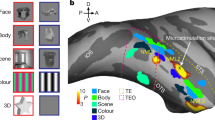Abstract
Brain imaging studies in humans have reported each object category was associated with different neural response pattern reflecting visual, structure or semantic attributes of visual appearance, and the representation of an object is distributed across a broader expanse of cortex rather than a specific region. These findings suggest the feature-map model of object representation. The present object categorization study provided another evidence for feature-map representation of objects. Linear Support Vector Machine (SVM) was used to analyze the functional magnetic resonance imaging (fMRI) data when subjects viewed four representative categories of objects (house, face, car and cat) to investigate the representation of different categories of objects in human brain. We designed 6 linear SVM classifiers to discriminate one category from the other one (1 vs. 1), 12 linear SVM classifiers to discriminate one category from other two categories (1 vs. 2), 3 linear SVM classifiers to discriminate two categories of objects from the other two categories (2 vs. 2). Results showed that objects with visually similar features have lower classification accuracy under all conditions, which may provide new evidences for the feature-map representation of different categories of objects in human brain.
Access this chapter
Tax calculation will be finalised at checkout
Purchases are for personal use only
Similar content being viewed by others
References
Gauthier, I.: What constrains the organization of the ventral temporal cortex? Trends Cogn. Sci. 4(1), 1–2 (2000)
Haxby, J., et al.: Distributed and overlapping representations of faces and objects in ventral temporal cortex. Science 293(5539), 2425–2430 (2001)
Hecaen, H., Angelergues, R.: Agnosia for faces (prosopagnosia). Arch. Neurol. 7(2), 92 (1962)
Assal, G., Favre, C., Anderes, J.: Nonrecognition of familiar animals by a farmer. Zooagnosia or prosopagnosia for animals. Revue Neurologique 140(10), 580 (1984)
Carmel, D., Bentin, S.: Domain specificity versus expertise: factors influencing distinct processing of faces. Cognition 83(1), 1–29 (2002)
Rossion, B., et al.: The N170 occipito-temporal component is delayed and enhanced to inverted faces but not to inverted objects: An electrophysiological account of face-specific processes in the human brain. NeuroReport 11(1), 69 (2000)
Liu, J., et al.: The selectivity of the occipitotemporal M170 for faces. NeuroReport 11(02), 337 (2000)
Kanwisher, N., McDermott, J., Chun, M.: The fusiform face area: a module in human extrastriate cortex specialized for face perception. J. Neurosci. 17(11), 4302 (1997)
McCarthy, G., et al.: Face-specific processing in the human fusiform gyrus. J. Cogn. Neurosci. 9(5), 605–610 (1997)
Kanwisher, N.: Domain specificity in face perception. Nat. Neurosci. 3, 759–763 (2000)
Fodor, J.A.: The Modularity of Mind. MIT, Cambridge (1981)
Downing, P.E., et al.: A cortical area selective for visual processing of the human body. Science 293(5539), 2470 (2001)
Epstein, R., Kanwisher, N.: A cortical representation of the local visual environment. Nature 392(6676), 598–601 (1998)
Tarr, I.G.M.J., et al.: Activation of the middle fusiform ‘face area’ increases with expertise in recognizing novel objects. Nat. Neurosci. 2(6), 569 (1999)
Gauthier, I., et al.: Expertise for cars and birds recruits brain areas involved in face recognition. Nat. Neurosci. 3, 191–197 (2000)
Tarr, M.J., Gauthier, I.: FFA: a flexible fusiform area for subordinate-level visual processing automatized by expertise. Nat. Neurosci. 3, 764–770 (2000)
Ishai, A., et al.: Distributed representation of objects in the human ventral visual pathway. Nat. Acad. Sci. 96, 9379–9384 (1999)
Ishai, A., et al.: The representation of objects in the human occipital and temporal cortex. J. Cogn. Neurosci. 12(Supplement 2), 35–51 (2000)
Haxby, J.V., Hoffman, E.A., Gobbini, M.I.: The distributed human neural system for face perception. Trends Cogn. Sci. 4(6), 428–432 (2000)
Chao, L.L., Haxby, J.V., Martin, A.: Attribute-based neural substrates in temporal cortex for perceiving and knowing about objects. Nat. Neurosci. 2, 913–919 (1999)
Tanaka, K.: Inferotemporal cortex and object vision. Ann. Rev. Neurosci. 19(1), 109–139 (1996)
Zhang, H., et al.: Face-selective regions differ in their ability to classify facial expressions. NeuroImage 130, 77–90 (2016)
Wegrzyn, M., et al.: Investigating the brain basis of facial expression perception using multi-voxel pattern analysis. Cortex 69, 131–140 (2015)
Kragel, P.A., Labar, K.S.: Multivariate neural biomarkers of emotional states are categorically distinct. Soc. Cogn. Affect. Neurosci. 10(11), 1437–1448 (2015)
Cowen, A.S., Chun, M.M., Kuhl, B.A.: Neural portraits of perception: Reconstructing face images from evoked brain activity. NeuroImage 94(1), 12–22 (2014)
Song, S., et al.: Comparative study of SVM methods combined with voxel selection for object category classification on fMRI data. PLoS ONE 6(2), e17191 (2011)
Acknowledgments
This research was financially supported by Young Scientist Fund of National Natural Science Foundation of China (NSFC) (31300924), NSFC General program (61375116), the Fund of University of JiNan (XKY1508, XKY1408).
Author information
Authors and Affiliations
Corresponding author
Editor information
Editors and Affiliations
Rights and permissions
Copyright information
© 2017 Springer International Publishing AG
About this paper
Cite this paper
Song, S., Zhang, J., Tong, Y. (2017). Objects Categorization on fMRI Data: Evidences for Feature-Map Representation of Objects in Human Brain. In: Zeng, Y., et al. Brain Informatics. BI 2017. Lecture Notes in Computer Science(), vol 10654. Springer, Cham. https://doi.org/10.1007/978-3-319-70772-3_10
Download citation
DOI: https://doi.org/10.1007/978-3-319-70772-3_10
Published:
Publisher Name: Springer, Cham
Print ISBN: 978-3-319-70771-6
Online ISBN: 978-3-319-70772-3
eBook Packages: Computer ScienceComputer Science (R0)




